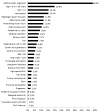Prospective Validation of the National Field Triage Guidelines for Identifying Seriously Injured Persons
- PMID: 26712244
- PMCID: PMC5323436
- DOI: 10.1016/j.jamcollsurg.2015.10.016
Prospective Validation of the National Field Triage Guidelines for Identifying Seriously Injured Persons
Abstract
Background: The national field trauma triage guidelines have been widely implemented in US trauma systems, but never prospectively validated. We sought to prospectively validate the guidelines, as applied by out-of-hospital providers, for identifying high-risk trauma patients.
Study design: This was an out-of-hospital prospective cohort study from January 1, 2011 through December 31, 2011 with 44 Emergency Medical Services agencies in 7 counties in 2 states. We enrolled injured patients transported to 28 acute care hospitals, including 7 major trauma centers (Level I and II trauma hospitals) and 21 nontrauma hospitals. The primary exposure term was Emergency Medical Services' use of one or more field triage criteria in the national field triage guidelines. Outcomes included Injured Severity Score ≥16 (primary) and critical resource use within 24 hours of emergency department arrival (secondary).
Results: We enrolled 53,487 injured children and adults transported by Emergency Medical Services to an acute care hospital, 17,633 of which were sampled for the primary analysis; 13.9% met field triage guidelines, 3.1% had Injury Severity Score ≥16, and 1.7% required early critical resources. The sensitivity and specificity of the field triage guidelines were 66.2% (95% CI, 60.2-71.7%) and 87.8% (95% CI, 87.7-88.0%) for Injury Severity Score ≥16 and 80.1% (95% CI, 65.8-89.4%) and 87.3% (95% CI 87.1-87.4%) for early critical resource use. Triage guideline sensitivity decreased with age, from 87.4% in children to 51.8% in older adults.
Conclusions: The national field triage guidelines are relatively insensitive for identifying seriously injured patients and patients requiring early critical interventions, particularly among older adults.
Copyright © 2016 American College of Surgeons. Published by Elsevier Inc. All rights reserved.
Figures




References
-
- MacKenzie EJ, Rivara FP, Jurkovich GJ, et al. A national evaluation of the effect of trauma-center care on mortality. N Engl J Med. 2006;354:366–378. - PubMed
-
- Mullins RJ, Veum-Stone J, Helfand M, et al. Outcome of hospitalized injured patients after institution of a trauma system in an urban area. JAMA. 1994;271:1919–1924. - PubMed
-
- Nathens AB, Jurkovich GJ, Rivara FP, Maier RV. Effectiveness of state trauma systems in reducing injury-related mortality: a national evaluation. J Trauma. 2000;48:25–30. discussion 30–31. - PubMed
-
- Pracht EE, Tepas JJ, 3rd, Langland-Orban B, et al. Do pediatric patients with trauma in Florida have reduced mortality rates when treated in designated trauma centers? J Pediatr Surg. 2008;43:212–221. - PubMed
-
- Cooper A, Barlow B, DiScala C, et al. Efficacy of pediatric trauma care: results of a population-based study. J Pediatr Surg. 1993;28:299–303. discussion 304–305. - PubMed
Publication types
MeSH terms
Grants and funding
LinkOut - more resources
Full Text Sources
Other Literature Sources
Medical
Miscellaneous

